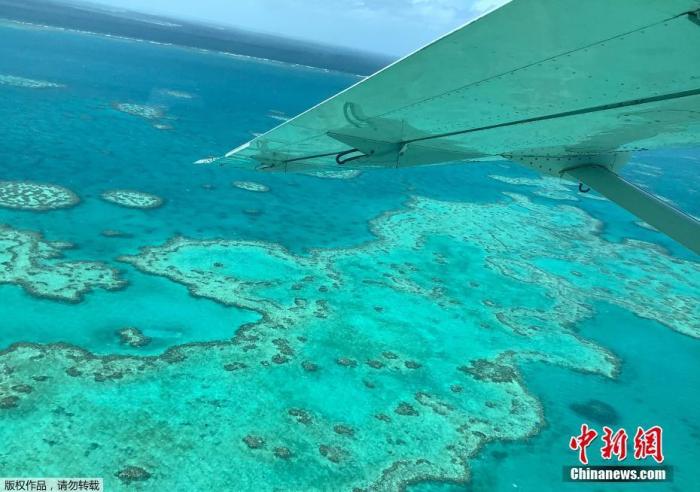China News Service, July 29. According to the British Broadcasting Corporation (BBC), the Great Barrier Reef is one of the most famous natural wonders in the world and one of Australia's most popular tourist attractions.
However, recently, many large-scale coral bleaching and other problems have exacerbated its environmental degradation.
The Great Barrier Reef was almost included in the "List of World Heritage in Danger."
The Great Barrier Reef is a well-known nature reserve in Australia. It was included in the "World Heritage List" in 1981 and was the first item on the list in Australia.
Data map: Coral.
In recent years, due to fossil resource mining and related cargo port construction, agricultural pollution, climate change, etc., the ecological deterioration of the heritage site has caused problems. The professional consulting organization World Conservation Union (IUCN) has repeatedly recommended that the World Heritage Committee consider including the project in the " List of World Heritage in Danger.
After discussion on July 23, the World Heritage Committee decided to postpone the review of the Australian Great Barrier Reef project until the 45th World Heritage Conference.
This decision gives the Australian government more time.
Australia said that it has invested more than 3 billion Australian dollars to improve the conditions of the Great Barrier Reef.
Climate change, pollutant emissions
The Great Barrier Reef faces multiple threats
Since 1995, global warming has caused the Great Barrier Reef to lose half of its corals.
Among them, dendritic corals, which are large in size and are habitats for a series of marine life, are particularly threatened.
Polyps are the backbone of coral reefs, and they are highly sensitive to sea temperature.
If the water temperature is too high, they will die.
In the past five years alone, the Great Barrier Reef has experienced three large-scale coral bleaching events.
Coral bleaching refers to the phenomenon of stressed corals expelling the algae that live in them. These algae both give them color and give them life.
These corals will turn white later, this process is also called bleaching.
Climate change will also cause ocean acidification and coral reef erosion.
If the seawater temperature drops again after bleaching, the coral reef may be restored.
The entire recovery process will take at least 10 to 15 years.
Data map: Australia's Great Barrier Reef.
But scientists warn that the Great Barrier Reef is now on the verge of collapse.
After the bleaching events in 2016 and 2017, a study found that there were not enough adult corals in the area to allow the most affected areas to regenerate normally.
In 2019, Australia lowered its long-term outlook for the Great Barrier Reef to "very poor".
The Great Barrier Reef Marine Park Authority has stated that climate change remains the biggest threat here.
On the other hand, over the years, human activities such as coastal development and agricultural pollutant discharge have also brought challenges to the health of the Great Barrier Reef.
Sediments, nitrogen and pesticides from nearby farms flow into the Great Barrier Reef, reducing water quality and allowing algae to grow.
Illegal fishing and even the destruction of corals by tourists during the journey are also problems facing the local area.
The natural enemy of corals, the crown of thorns starfish, is another big problem.
With the decrease of surrounding marine life, the number of crown of thorns starfish has increased rapidly.
A single crown of thorns starfish can destroy a large area of coral.
Experts call to reduce greenhouse gas emissions
What more protection measures need to be done?
After the bleaching incident in 2016 and 2017, the Australian government promised to provide a rescue plan worth 500 million Australian dollars to the Great Barrier Reef.
These measures include killing the crown of thorns starfish and paying farmers to reduce the discharge of agricultural materials to the Great Barrier Reef.
But critics say that there are no measures in this plan to address the major threat of climate change.
Experts warn that the only way to save coral reefs is to immediately reduce greenhouse gas emissions.
The United Nations stated that even if the world controls global warming at 1.5 degrees Celsius, 90% of the world’s corals will still die.
Since the pre-industrial revolution, global temperature has risen by about 1 degree Celsius.
Scientists say that people must abandon the use of fossil fuels.
Australia pointed out that climate change is a global issue, but critics still said that the Australian government is delaying.
As one of the world's largest exporters of fossil fuels, Australia continues to advocate the use of coal, natural gas and oil.
The country is also lobbying against UNESCO’s listing of the Great Barrier Reef as a "endangered" heritage list.
Queensland, the home of the Great Barrier Reef, is one of the most intensive areas of coal mining in the world.
Australia has already committed to a 2030 emission target that will reduce emissions by 26% from 2005 levels, but the United Nations says Australia is not on the right track to achieve this goal.
Although the United States, the United Kingdom and many European and Asian countries have pledged to achieve net zero emissions by 2050, Australia, under pressure, has not made the same pledge so far.

